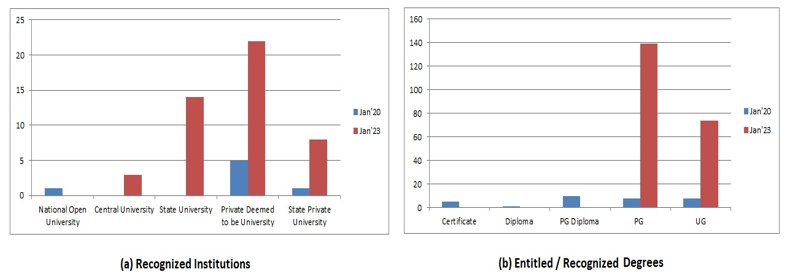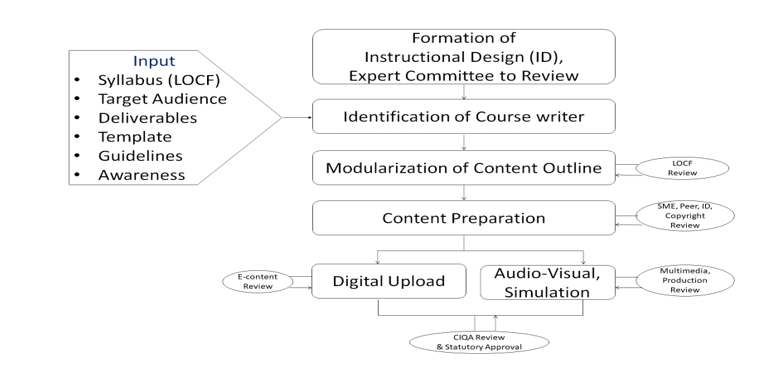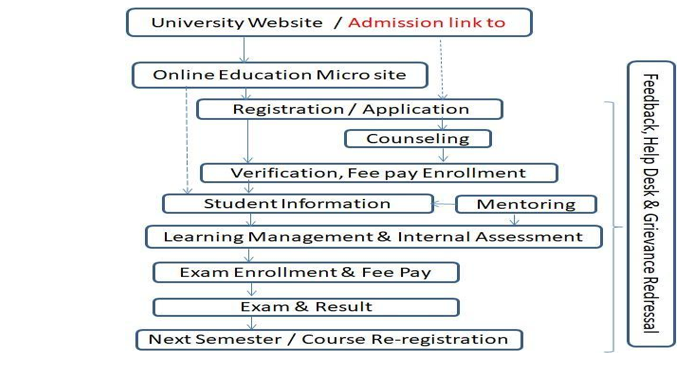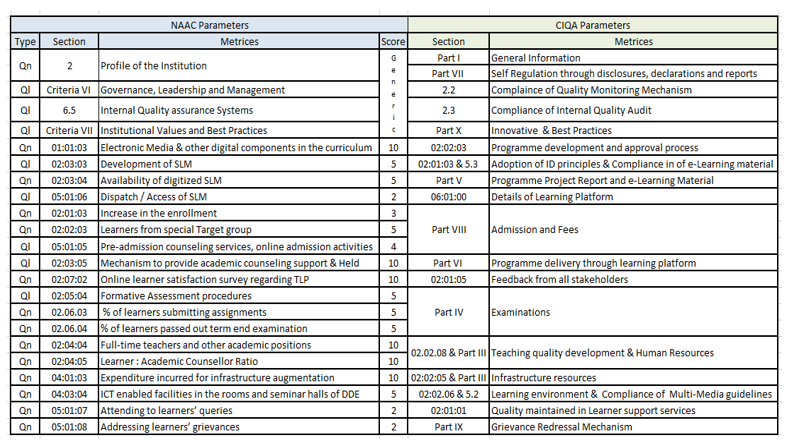Abstract
The higher education system of India is one of the largest systems on the globe, where there is a huge young population. The central government aims to increase the higher education gross enrolment ratio, which will improve the living and economic standards of youth. However, enrolment in higher education is lower for many reasons, including the accessibility of institutions in the rural region and the affordability of learning. The institutional capacity cannot be expanded in an accelerated manner with more than three times the existing capacity in a short period of time. As an alternative, the regulation to award degrees and diplomas through online education is formulated with the assurance of recognition on par with regular degrees and diplomas. The regulatory norms, recognition process, human resources, infrastructure requirements, and quality mechanisms of online programs are reviewed in this paper.
Keywords: Online Degree, UGC, AICTE, Learner support services, Technology stack, NDU
Introduction
The technological advancements and low-cost access made online education more natural and affordable across all regions. The usage of smartphones is on the rise among millennial students, including the rural regions. Few state governments provide free laptops to school children studying in government schools. The government promotes online education in the form of MOOC (Massive Open Online Courses) learning through SWAYAM (Study Webs of Active Learning for Young Aspiring Minds) for science and humanities courses and NPTEL (National Programme on Technology Enhance Learning) for engineering and technology courses. These initiatives help students access educational resources from premium institutions online. There is a provision to transfer credit through MOOC courses for regular campus students as per the guidelines of (“UGC (Credit Framework for Online Learning Courses through Swayam, Regulation”, 2016). The success of such initiatives within India and the boom of online degree courses around the world have opened the door to offering full-fledged online degree courses. The University Grants Commission (UGC) has provided detailed guidelines to ensure quality in every aspect. The study reviews the approval process, technological requirements, and content delivery mechanisms.
Institutional Eligibility & programs
As per the Gazette notifications released as (“University Grants Commission (Open and Distance Learning Programmes and Online Programmes) Regulations”, 2020) the higher education institutions (HEI) are permitted to offer postgraduate (PG) and undergraduate (UG) programs that are either recognized or entitled based on their National Assessment and Accreditation Council (NAAC) score and National Institutional Ranking Framework (NIRF) as listed in Table 1. The All India Council for Technical Education (AICTE) also added a few guidelines as “AICTE ODL and Online guidelines”, 2021, with minimum score in the National Board of Accreditation (NBA) and the approval process to offer professional programs. The Master of Computer Applications (MCA) and Master of Business Administration (MBA) programs fall under this category. Such multi-regulatory approvals make the process cumbersome, and there is a need for a seamless single-mode approval process upon implementation of the new education policy. The institutions can offer the online program with an intake of three times the regular capacity only when it is offered in regular mode with a minimum of one batch passed out. The degree nomenclature should adhere to the UGC notification of degree specifications, 2014.
Table 1. Institutional Eligibility
| Category | Eligibility conditions | Remarks |
Without prior approval of UGC for June 2020 and January 2021 |
| A maximum of 10 PG and 3 UG programs can be offered. However, HEI must submit the application through the UGC portal. |
With prior approval of UGC (Committee visit) |
| Open universities that have prior permission must submit an affidavit of obtaining NAAC within the recognition period. |
The institutions recognized in the year 2020 were reviewed with steering committee visits for content readiness, manpower, and seamless technology stack flow. The highest-ranked institutions were recognized in 2021 based on the online submission of applications with self-declarations and links for assessing the quality parameters with no physical review under the prior approval category. The growth of online education in India can be visualized by the number of institutions and programs approved in 2020 and 2023, as listed in Figure 1 from the list of “Recognized Higher Education Institutions to offer Online Programs”, 2023). The increase in enrolment in online education is listed in Table 2 (Gohain, 2022). The decrease in international students must be addressed at an early stage with quality content and support services, as admission is mainly taking place through the Ministry of External Affairs with a full waiver of tuition fees for developing countries. Both private and deemed universities attract more admissions across India. In addition, a few institutions of national importance such as Indian Institute of Technology are also offering online degree programs that do not require any prior UGC approval process. The number of PG programs, especially those offering MBAs with different specializations, has increased. The online degree will be helpful to enhance the qualifications of students through the provision of continuing education while working. Few HEIs offer customized programs to corporate employees to meet their job requirements. This also helps the institutions increase admissions through bulk enrolments. The student enrolment, completion rate, and recognition of online degree courses are yet to be realized. The learners are recommended to visit the UGC website to confirm the recognition of the institutions.
Figure 1. List of HEIs and programs for the January 2020 & 2023 sessions

Table 2: Comparative status of Online Admissions in 2021 & 2022 (Source : Manish G, TOI, Oct 2022)
| Comparative status | 2020-21 | 2021-22 |
| No. of HEIs | 42 | 58 |
| No. of Programmes | 237 | 345 |
| Indian Enrolment | 21954 | 70023 |
| International Enrolment | 3951 | 2377 |
| Total Enrolment (Fresh Admissions) | 25905 | 70023 |
Due care is taken not to offer any learning program through online mode in disciplines that requires in-person practical training such as engineering, architecture, medical, physiotherapy, occupational therapy, paramedical, pharmacy, nursing, dental, agriculture, horticulture, hotel management, catering, culinary, visual arts, and sports. The M.Phil. and Ph.D. research programs of all disciplines are also prohibited from being offered in online mode. The regular programs offered only in affiliated colleges of the universities cannot be offered through ODL (online mode). The guidelines are compiled for both ODL and online, with common and specific regulations for each mode. However, a few provisions of ODL and online mode vary in some of the specifications listed in Table 3.
Table 3. Various of Provisions for ODL and Online Mode in UGC Guidelines, 2020
| Provisions | ODL Mode | Online Mode |
| Territorial Jurisdiction | Applicable. The deemed university, which is governed by UGC, can offer only in their headquarters or off-campus | Not applicable |
| Learner support centre | Applicable within the territory | Not applicable |
| Science based programmes | HEI of "without prior approval category". Only in headquarters or Learner support centres that have existed for a minimum of 7 years and offer the program | Science programs that require laboratory courses to be prohibited |
| Examination | Permitted to conduct online exams. However, there is no clarity on conducting a remote proctored exam where the students can write exams from their homes. | Allowed to conduct either exams at exam centres or Remote proctored examinations. |
| Assignment | Table 2. Norms for ODL insist on a number of assignments based on course credits. | There is no explicit mention of assignments. |
The learner support centres located off-campus and within the territorial jurisdiction are permitted for ODL. The franchise arrangement for admission, conduct of classes, and content development is strictly prohibited for both ODL and online programs. There are a few clauses in the guidelines that contradict each other, as listed in Table 4. As per clause 15. (A) (3), the regulation restricts the institution from adapting the weightage of assessment similar to campus programs.
Table 4. Contradictions in the guidelines
| Provisions | Descriptions | Contradictions |
| Teaching Learning & Exam Process | Clause 4. (A). (v) Teaching, learning, examinations and question paper to be common for both campus and ODL / online programme in dual mode universities | Clause 15. (A) (3) In-semester assessment: 30 % and end semester exam: 70 % |
| Conduct of Examination | Clause (15) (C) The online remote proctored examination can be conducted | Clause 16. (2) Mention the name and address of examination centre in certificate |
| Quality Assurance | The institutions must establish Centre for Internal quality assurance (CIQA) | The NAAC accredited institutions have been established with IQAC, where CIQA will be a redundant process with similar & extended objectives. |
| Certificate / Diploma / Advanced Diploma | The eligible HEIs are permitted to offer certificate and diploma programs, but the credits and duration are not mentioned. | The UGC 2018 guidelines had provisions to apply for certificate and diploma programs while submitting the applications. |
| PG Diploma programs | Both UGC 2020 and AICTE 2021 guidelines mention a 2-year PG diploma with minimum of 80 credits | AICTE guidelines mention about postgraduate certificate or post diploma with the minimum duration of more than a year, less than 2 years make institutions to revise the existing flexible exit upon completion of one year |
| Maximum duration of the program | N+N years (Two times of minimum duration) | N+2 years for regular programs as per the guidelines of UGC released in the year 2015 |
The duration of a PG diploma for two years in the new guidelines is questioned, as there are several HEIs offering a one-year PG diploma for more than a decade, including the online programs recognized during the 2020 session. The disparity in the maximum duration of program completion is to be sorted.
Content Development and Delivery
The HEIs are recommended to create e-content in a four-quadrant approach, grouped with synchronous and asynchronous activities listed in Figure 2. The availability of content requirements at the time of application submission is a minimum of two and three semesters for PG and UG programs, respectively. The institutions are recommended to follow the (“Guidelines for development and implementation of MOOCs, Massive Open Online Courses, an initiative under National Mission on Education through Information Communication Technology (NME-ICT) Programme”, 2015) released by the Ministry of Human Resource Development (MHRD). The institutions are encouraged to develop and utilize in-house contents and permitted to outsource only 40% of contents from open educational resources (OER) or approved MOOC platforms by their statutory council.
Figure 2. Four Quadrant Approach with Synchronous and Asynchronous Activities

Table 5 Norms for Online Content Delivery (Source: Table 3 of UGC Guidelines, 2020)

There is a specific norm for content delivery as listed in Table 5, which is sourced from Table 3 of the UGC guidelines for 2020, where the learners must have a minimum participation of 75% including all learning activities to appear for the end-of-semester examination.
The global pandemic due to COVID-19 created an online teaching and learning platform for all the institutions and faculty members. The student community has also experienced online learning, including the enrolment of skill-based MOOC content from the non-formal education sector and international agencies. As the learners have a wide choice of institutions and courses, the HEIs must ensure the quality of the contents and courses. The review of e-content involves multiple stakeholders, such as subject matter experts (SME), instructional designers (ID), and technical delivery, as shown in Figure 3, where the syllabus is framed as per the Learning Outcome-based Curriculum Framework (LOCF) of UGC guidelines. The checklist given in Table 6 will be the basis for the content review.
Figure 3. E-Content Review

Table 6. List of parameters used in E-content review
| Audio-Video material | E-Content |
|
|
| Content review parameters | |
|
|
The learners have multiple choices to upgrade their skills through online courses, as the market is flooded with plenty of online courses by non-formal education sectors, either as stand-alone courses or in alliance with faculty members of higher education institutions. These courses are widely recognized for employment opportunities by private organizations and multinational companies as they demonstrate industrial skill requirements. This has necessitated online degree courses offered by higher education institutions on par with industry programs with respect to skill and competency. The online courses offered by non-formal sectors and international agencies edge out some of the quality parameters listed in Table 7.
Table 7. Quality comparison of formal and non-formal online course offerings
| Parameters | Formal | Non-formal |
| Web page update | Periodic interval | On-demand |
| Announcement & Notification | Periodic, Detailed | Prompt, Attractive |
| LMS organization | Static setup | Dynamic |
| Technology stack | Lengthy | single sign on |
| Content modularization | As per curriculum | As per skill competency |
| Skill based content | Theory + Skill | focus on competency |
| Multimedia & simulated content | Limited | Dynamic & Interactive |
| Virtual lab tools for technology | Open source, limited | Industry expectations |
| Live lectures | As per guidelines | Limited |
| Variety in assessment | As per regulations | Multiple options |
| Self-reflection on learning | Limited | Instant feedback |
| Learner tracking & Dashboard | Static | Interactive |
| Discussion forum | As per regulations | Interactive |
| Project based learning | As per regulations | Real time Problem solving |
| Content revisions | As per guidelines | On-demand upgrade |
| Degree certifications | As per regulations | Course level certifications |
Learner support services
The technology usage in the complete life cycle of online education service from pre-admission, counselling, admission, learning, guidance, mentoring, and the conduct of exams and grievance redressal mechanisms to cater to the needs of remote learners is shown in Figure 4.
The learning management system (LMS) plays a vital role in active learning engagement. The absence of face-to-face teaching and peer interaction have to be managed thorugh live classes, interactive video lectures, self-reflection on learning, discussion forums, and distributed collaborative projects. The UGC has issued guidelines on assessing non-SWAYAM platform technology to ensure the seamless workflow of the technology stack by institutions offering online programs. The assessment parameters of the non-SWAYAM platform are listed in Table 8.
Figure 4. Tech stack flow of an Online degree

Table 8. Assessment parameters to recognize online programs
| User friendliness | Announcement & notifications |
| Learner engagement & interactivity | Online payment gateway |
| Flexibility (browser, device) | Mentoring & grouping learners |
| Engaging & assessing learners | Dashboard options |
| Synchronous interaction | Proctored examination |
| Asynchronous interaction | Examination support (MCQ, descriptive) |
| Peer group activities | Online assignments & graded discussions |
| Collaborate learning communities | Online access to certificates |
| Course storage and management | Plagiarism monitoring |
| Security & IP tracking | Four quadrant approach |
| Scalability | Adaptive learning path |
| Team to run the platform | Training MOOC & Ensure quality |
Resource Requirements
The human resource and infrastructure requirements are detailed in the guidelines, as shown in Table 9. While the institutions are expected to appoint dedicated teams for content development and online delivery of the program, there is a provision to outsource the technical support. The HEI can identify and engage education technology vendors for multimedia production, animations, and other software components of the technology stack.
Table 9. Human Resources and Infrastructure requirements
| Human Resources |
Administration: Director, Deputy Director (Technical), Assistant Director Office : Deputy & Assistant Registrar, Section officer, Computer Operator Academic : Program & Course Coordinators, Course Mentors, Examiners Technical Development : Production / Audio-Video Recording/ Editing : Associate / Assistant Delivery : LMS & Data Management : Manager / Assistant Admission & Examination: Manager / Assistant |
| Minimum Infrastructure / Software Requirements |
Audio-Video recording room with all infrastructure Audio-Video recording / editing / production software Technology stack software |
This will help the HEI minimize the initial investment in technical development. However, there are a few concerns about the eligible public or aided institutions and scaling up the offer of programs as some of them are functioning with a shortage of faculty and funds.
Quality Assurance
Both ODL and online programs offered by HEIs face several challenges and criticisms about quality delivery. The members of CIQA are suggested to ensure the quality of learner support services, interaction, feedback, and the program development process, including the curriculum plan, design, development, academic flexibility, e-content quality, teaching and learning processes, and assessment methodologies. It is required to conduct an academic audit every five years to ensure the quality of the academic plan, content development, teaching and learning process, program delivery, and evaluation. The NAAC (“Manual for Self-study Report Dual Mode Institutions”, 2023) lists a set of quality parameters for dual-mode universities with a set of qualitative (Ql) and quantitative (Qn) metrics related to ODL, which requires further revisions with respect to online education. The CIQA academic audit report of UGC-DEB analyses the institutional capabilities on human resource and infrastructural requirements, standards of LMS used, quality content and curriculum delivery through the program project report, four quadrant eLearning material, learner support services, examinations, feedback system, grievance redressal mechanism, and innovative best practices. The CIQA annual report template is comprehensive and different for both ODL and online education courses. In Table 10, NAAC ODL and CIQA OL parameters are mapped to understand the enhancement of quality assessment required at both NAAC and CIQA with respect to OL degree programs. The NAAC manual is to be updated for specific online program offerings such as the four-quadrant approach and seamless integration of learning platforms with respect to support services and LMS. In the CIQA report, there is an attachment provision for evidence, but there is no specific general format or quantitative weighting.
Table 10. Mapping of NAAC ODL and CIQA Online Parameters

Comparison of quality accreditation with international standards
Higher education agencies around the world have similar guidelines and accreditation parameters to ensure the quality of online degree courses. The same agencies that accredit campus programs also evaluate the online program. Though there are no specific guidelines on the recognition of online degree course offerings similar to UGC guidelines, there are specific accreditation parameters to ensure online course quality. The Distance Education Accrediting Commission (DEAC) of the USA has similar standards to NAAC as listed in Table 11, with more elaborations on financial disclosures, promotional literature, student support services, record protection, and retention (“Accreditation Handbook”, 2022). The Council for Higher Education Accreditation (CHEA) of the USA also accredits online programs similar to campus programs, which expect self-disclosure on accrediting standards and evidence. There is a need to evolve specific parameters pertaining to online degree courses.
Table 11. DEAC standard parameters for Distance courses
| Standards I to VI | Standards VII to XII |
Brief Institutional Mission Institutional Effectiveness & Strategic planning Program outcomes, curricula & SLM Learner support services Learner progress, achievement and satisfaction Academic Leadership and faculty qualification | Marketing, promotional literature & recruitment personnel Admission guidelines and enrolment criteria Financial Management and refund policies Institutional governance Financial and managerial responsibility Facilities, reports, records, document protection & retention |
MOOC credit transfer
The (“Accreditation of Online courses in Higher Education – Early adopters in the European Union, India, Indonesia, and Malaysia”, 2021) summarises the recognition of MOOC credit transfer to regular campus students. The regulatory frameworks for MOOC credit transfers are well-defined and summarized in Table 12. In India, there is a further development by designing the framework of an academic bank of credits (ABC), where students can accumulate their credits earned through regular campus programs and MOOC courses (“Academic Bank of Credits regulations”, 2021). It is further planned to establish the National Digital University (NDU), where students who have obtained credits above 50% through MOOCs will be entitled to obtain a degree from NDU. This benefits the Indian students who are unable to complete the courses through regular mode, minimizes dropouts, and increases the gross enrolment ratio of the country.
Table 12. List of countries offering MOOC credit Transfers
| Country | Credit Transfer | Quality Assurance |
| Malaysia | Up to 30 % per program | Malaysian Quality Assurance (MQA) |
| India | Up to 40 % per semester | Academic Bank of Credits (ABC) SWAYAM Academic board |
| Indonesia | Up to 40 % per program | Ministry of Education and Culture (MOEC) |
| European Union | Decisions by individual universities | European credit transfer system and micro-credential framework |
Conclusion
Full-fledged online degree courses are in their early stages in India. There is a need for different operations with respect to institutional branding, digital marketing, flexible fee payment options, modular industry-oriented curriculum, quality content, collaborative project-based learning, partnerships with corporations for course delivery and customized programs for their employees, work-integrated learning patterns, and smooth user experiences. As only the top accredited and ranked higher education institutions are permitted to offer full-fledged online degree courses, the approval process should be quick and further simplified, with permissions to run with the regular faculty of institutions instead of a dedicated setup. The elimination of multi-regulatory approvals will encourage a greater number of institutions to participate.
References
1. Academic Bank of Credits regulations. (2021). https://www.ugc.gov.in/pdfnews..., , UGC
2. Accreditation of Online courses in Higher Education – Early adopters in the European Union, India, Indonesia, and Malaysia. (2021). https://www.adb.org/sites/defa..., Asian Development Bank, Vol 196,
3. AICTE ODL and Online guidelines. (2021). https://www.aicte-india.org/si...
4. Accreditation Handbook. (2022). https://www.deac.org/Seeking-A..., Distance Education Accrediting Commission,
5. Guidelines for development and implementation of MOOCs, Massive Open Online Courses, An initiative under National Mission on Education through Information Communication Technology (NME-ICT) Programme. (2015). https://www.aicte-india.org/do..., MHRD, Department of Higher Education, F.No. 8-1/2015-TEL
6. Gohain. (2022, October 22). Enrollment for online education up 170% in 2022, distance learning 42%, https://timesofindia.indiatime...
7. Manual for Self-study Report Dual Mode Institutions. (2023),
http://naac.gov.in/index.php/e...
8. University Grants Commission (Open and Distance Learning Programmes and Online Programmes) Regulations. (2020). https://www.ugc.ac.in/pdfnews/...
9. UGC (Credit Framework for Online Learning Courses through Swayam, Regulation,. (2016). https://www.ugc.ac.in/pdfnews/...(Credit-Framework-for-Online-Learning-Courses-through-SWAYAM)-Regulation,-2016.pdf
10. Recognized Higher Education Institutions to offer Online Programs, https://deb.ugc.ac.in/notices/...

